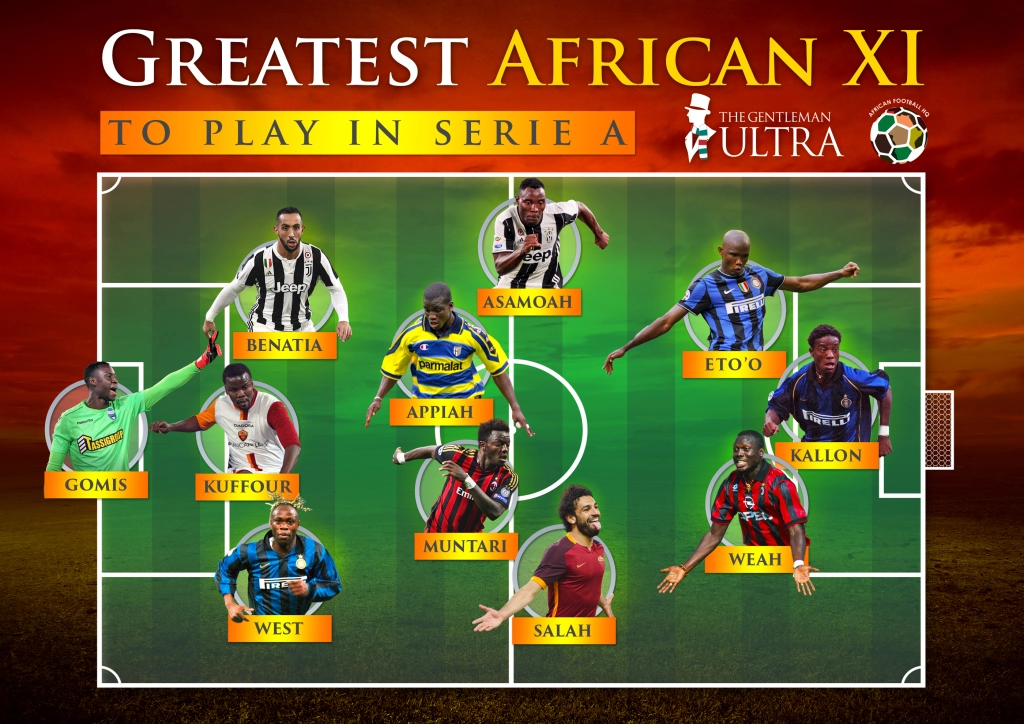 Many great African players have graced Serie A over the years and choosing a best-XI was not an easy task. Luckily, our good friends over at African Football HQ were up to the challenge – here’s their final XI.
Many great African players have graced Serie A over the years and choosing a best-XI was not an easy task. Luckily, our good friends over at African Football HQ were up to the challenge – here’s their final XI.
This best XI is based on skill, success and time spent in Italy. Many of the greatest African footballers had short spells in Serie A, so only those who played in Italy for at least two seasons were short-listed. Finally, due to the attacking nature of the final XI, a 3-4-3 formation was chosen.
Goalkeeper: Alfred Gomis
Brothers Lys and Alfred Gomis are the only African goalkeepers to play in Serie A. The sons of Senegalese immigrants, they were developed at the Torino academy and then loaned out a combined 12 times. Lys eventually made his Serie A debut as a substitute in November 2013 but was unable to stick with a club and is now playing in the Italian third division.
In contrast, younger brother Alfred had a more successful career, signing a loan deal (with an obligation to buy) with SPAL before the 2017/18 season. He made a total of 46 league appearances with the Biancazzurri before he was transferred to French side Dijon. The lack of African goalkeepers in Italian football made this an easy pick.
Centre-back: Taribo West
The Nigerian defender – and cult hero amongst fans of Football Manager – is one of the greatest Africans to have graced Serie A. He joined Internazionale from Auxerre in 1997 and scored the winner in their UEFA Cup quarter-final against Schalke in his debut season – the year they won the competition. In his second season, West made a further 21 appearances before falling out of favour with the management and being transferred to arch-rivals Milan in January 2000. After just four appearances, he was loaned to English side Derby County and then sold to German club FC Kaiserslautern. The 1996 Olympic gold medalist recently claimed that the mafia put a stop to his time in Milan. West later spent 18 months in Serbia with FK Partizan where he won a league title and helped guide the club the group stage of the 2003–04 UEFA Champions League.
Centre-back: Samuel Kuffour
Legendary Ghanaian centre-back Samuel Osei Kuffour began his European career in Italy when Torino signed him aged just 15. Two years later, he signed for Bayern Munich, where he dominated the Bundesliga for 12 years with his killer combination of strength and agility. He won six German championships with Bayern before moving to AS Roma in 2005. However, a poor relationship with boss Luciano Spalletti, who refused to release Kuffour for international duty, hindered his spell in the capital. The following season, he was loaned out to UEFA Cup competitors Livorno, where he made 26 appearances before an unsuccessful loan spell at Ajax.
Centre-back: Mehdi Benatia
Moroccan defender Mehdi Benatia was a consistent performer in the Italian top flight for several seasons. From 2010-2013 he impressed with 80 league appearances and six goals for Udinese. He then switched to AS Roma, where he had a breakout year, scoring six goals as the capital club finished second in the league. His performances caught the attention of Bayern Munich, who paid €26 million for his services, only to use him as a back-up defender for two years.
In the summer of 2016, he joined Juventus on a season-long loan with an option to buy which the club triggered a year later. In his three seasons in Turin, he made 60 appearances and scored five goals including two in the 2018 Coppa Italia Final. In 2019, he left to spend his twilight years in Qatar with Al-Duhail.
Left-midfield: Kwadwo Asamoah
Kwadwo Asamoah will be remembered by Italian football fans as a solid and consistent performer for Juventus’ great sides of the 2010s. Like Kuffour and Gomis, Asamoah came through the Torino academy. After being signed by Udinese in 2008, he established himself as a midfield boss for club and country. Excellent performances with Ghana at the 2010 World Cup and AFCON garnered attention from Europe’s best.
He signed for Juventus in 2012, where he featured on the left-wing and in midfield. He was a crucial member of the Scudetto-winning sides of 2013 and 2014 and featured in the 2013/14 Serie A Team of the Season. He won four more Serie A titles and seven other trophies despite being hampered by injuries. In 2018 he transferred to Internazionale, where he made 42 appearances in his first season before losing his starting position in the current campaign.
Centre-midfield: Stephen Appiah
Ghanaian midfielder Stephen Appiah played for six Serie A teams. He initially joined Udinese in 1997 as a striker after impressing at the U17 World Cup but eventually moved to the central midfield role. Like others on the list, injuries derailed his time in Italy. A battle with viral hepatitis delayed his transfer to Parma but when he finally got there, he picked up a Coppa Italia medal.
After two seasons at Parma, he was loaned to fellow top-flight side Brescia, where his form improved further. He scored seven goals in 31 Serie A matches (his highest tally in Italy) and caught the eye of Juventus, who signed him on loan before making the deal permanent. In his first season, he made 30 appearances in the league and 46 in all competitions, picking up a Supercoppa Italiana medal along the way. The next season, his featured less and was sold to Fenerbahce.
A knee injury almost put a stop to his career in Turkey and but he recovered and moved back to Italy to play with Bologna in November 2009. There, he featured just twice before joining Cesena the next summer. He made a further 14 Serie A appearances but it was clear his time at the top was over.
Centre-midfield: Sulley Muntari
Ghanaian Sulley Muntari played his best football in Italy after switching from left-back to midfield. Aged just 17, he joined Udinese (have you noticed a trend with Udinese and Africans?) an by his third season, he was a regular, making over 40 appearances in all competitions. After a spell in England with Portsmouth, he joined Internazionale where he won two Serie A titles, two Coppa Italias and the UEFA Champions League. He later joined Milan, where he enjoyed four solid but trophyless seasons.
Right-midfield: Mohamed Salah
Mohamed Salah’s stint in Italy will go down in history as the calm before the storm. Football analysts will crunch the stats to find out what Liverpool saw in the Egyptian winger but his time in Italy was characterized by the gradual improvement that had kept him under the radar until Liverpool took notice. After a disappointing time at Chelsea, Fiorentina signed him on an 18-month loan in February 2015. In 16 league games, Salah recorded nine goals and three assists – nothing groundbreaking, but enough to attract the attention of Roma, who took over his loan deal with an option to make it permanent. In his first season with Roma, Salah recorded 14 goals and six assists in 34 appearances. The next season, he added another 15 goals but more than doubled his assist tally, contributing to 28 goals and convincing Liverpool to pull the trigger on a €42m deal.
Forward: Samuel Eto’o
For many, Samuel Eto’o is the greatest African footballer of all time. Among his long list of accomplishments for club and country, he enjoyed two successful seasons with Inter where he scored 53 goals in 102 games in all competitions. In his first season, he helped the club win a coveted league, cup and UEFA Champions League treble – a feat he achieved with Barcelona the year before – plus the Italian Super Cup and Club World Cup. Another Coppa Italia followed the next season along with 37 goals.
Forward: George Weah
George Weah. What is there to say? The current President of Liberia is the only African to win the Ballon d’Or and is the all-time leading African goalscorer in Serie A. A scorer of great goals, his strike against Verona where he controlled a corner in his box and took on half of the opposition before scoring is iconic.
Playing under Fabio Capello, Weah won Serie A in his first season (1995/96) with Milan and won it again in 1998/99. In four-and-a-half seasons with the Rossoneri, Weah scored 46 Serie A goals before moving to the Premier League with Chelsea.
Forward: Mohamed Kallon
The final striker position was the hardest to pick but the underappreciated Mohamed Kallon got the final nod. Hailing from Sierra Leone, a country not known for its football, Kallon is the second-highest African goalscorer in Serie A history (39) and the all-time top goal scorer for his country. He was signed by Internazionale in 1995 but was loaned out four times. A bench-warming stint at Bologna preceded a loan to Serie B side Genoa, where he scored 10 goals.
By 2001, Inter were finally ready to take a chance on Kallon. Injuries to Ronaldo and Recoba saw Kallon play 29 Serie A matches, scoring 9 goals as the team’s second-highest scorer, as Inter narrowly missed out on the league title and a UEFA Cup final appearance. Injuries and an eight-month drug suspension saw him play significantly less in the next two seasons before he was finally sold to AS Monaco.
Words by African Football HQ

